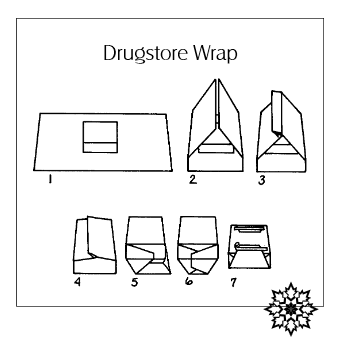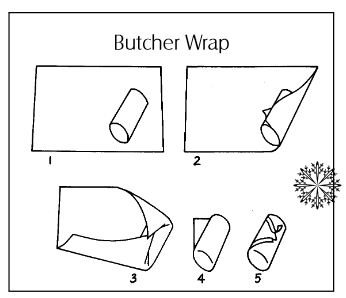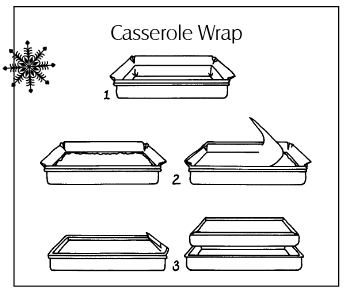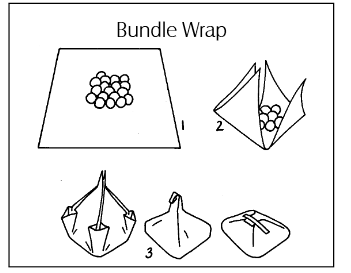Food Freezing Guide (FN403, Reviewed Feb. 2019)
Availability: Web only
■ Introduction
Freezing is one of the easiest, quickest, most versatile and most convenient methods of preserving foods. Properly frozen foods maintain more of their original color, flavor and texture and generally more of their nutrients than foods preserved by other methods.
Good freezer management is important. The following tips will help you get the most of your freezer dollar.
- Place your freezer in a cool, dry area where the temperature is constant.
- Keep your freezer at least ¾ full for efficient operation.
- Continue to use and replace foods. Do not simply store them.
- Open the freezer door as rarely as possible.
- Make proper use of energy saving features on your freezer.
- Keep door seals clean and check for proper sealing. Replace when necessary.
- Defrost manual freezers regularly.
- Keep the condenser coils clean.
■ Factors Affecting Quality
The condition of the food at the time of freezing will determine the final quality of the frozen food. Frozen food can be no better than the food was before it was frozen. Freezing does not sterilize foods as canning does. It simply retards the growth of microorganisms and slows down chemical changes that affect quality or cause food spoilage.
Enzymes
Freezing, heating and chemical compounds can control enzyme actions. Freezing slows enzyme activity so that many frozen foods, such as meats and many fruits, will keep satisfactorily with little or no further treatment.
Enzymes in vegetables are inactivated by heat during the recommended blanching process. Enzymes in fruits, causing browning and loss of vitamin C, are controlled by chemical compounds (antioxidants).
Air
Oxygen in the air may cause flavor and color changes if the food is improperly packaged.
Microorganisms
Microorganisms do not grow at freezer temperature, but most are not destroyed and will multiply as quickly as ever when the frozen food is thawed and allowed to stand at room temperature.
Ice Crystals
The formation of small ice crystals during freezing is desirable. Fast freezing is the most practical way to form small ice crystals. Large ice crystals associated with slow freezing tend to rupture the cells, causing an undesirable texture change.
Freezer Temperature
Maintain temperature of 0 degrees Fahrenheit or less to keep frozen foods at top quality. The storage life of foods is shortened as the temperature rises. For example, the same loss of quality in frozen beans stored at 0 F for one year will occur in three months at 10 F, in three weeks at 20 F, and in five days at 30 F.
Fluctuating temperatures result in growth in the size of ice crystals, further damaging cells and creating a mushier product. Changes in temperature can also cause water to migrate from the product.
Evaporation of Moisture
Improperly protected food will lose moisture, color, flavor and texture. Ice crystal evaporation from an area at the surface results in freezer burn, which is a dry, grainy, brownish area that becomes tough. Freezer burn does not render a food unsafe, only less desirable.
Packaging Materials
The prime purpose of packaging is to keep food from drying out and to preserve nutritive value, flavor, texture and color. Labels on packages will say if the product is suitable for freezer storage. A good packaging material should have the following characteristics:
- Moisture/vapor-proof or at least moisture resistant.
- Made of food grade material, i.e. designed to be used for food products.
- Durable and leakproof.
- Doesn’t become brittle and crack at low temperatures.
- Resistant to oil, grease or water.
- Protect foods from off flavors and odors.
- Easy to fill and seal.
- Easy to mark and store.
The packaging you select will depend on the type of food to be frozen, personal preference and availability. For satisfactory results, do not freeze fruits and vegetables in containers larger than one-half gallon.
Packaging not sufficiently moisture/vapor-resistant for long-time freezer storage includes ordinary waxed paper and paper cartons from ice cream and milk.
Rigid Containers
Rigid containers are made of plastic, glass, aluminum and heavily waxed cardboard and are suitable for all packs. These are often reusable. Straight or tapered sides on rigid containers make it much easier to remove frozen foods.
Glass jars used for freezing should be made for the purpose. Regular glass jars may not withstand the extremes in temperature. Do not use regular, narrow-mouth canning jars for freezing foods packed in liquid. Expansion of the liquid could cause the jar to break at the neck.
Cans, such as shortening and coffee cans, are good for packaging delicate foods. Line the can with a food-storage bag and seal the lid with freezer tape because they are not airtight.
Baking dishes can be used for freezing, heating and serving. Dishes may be covered with a heavy aluminum foil taped with freezer tape. To reuse the baking dish after the food is frozen, wrap the food in casserole-wrap fashion.
Ice cube trays are good for freezing foods in small amounts. Freeze food until firm and then transfer to freezer bags.
Flexible Bags or Wrapping
Bags and sheets of moisture/vapor-resistant materials and heavy-duty foil are suitable for dry packed vegetables and fruits, meat, fish or poultry. Bags can also be used for liquid packs. Protective cardboard cartons may be used to protect bags and sheets from tearing and to make stacking easier.
Laminated papers made of various combinations of paper, metal foil and/or cellophane are suitable for dry packed vegetables and fruits, meats, fish and poultry. Laminated papers are also used as protective overwrap.
Packaging, Sealing and Labeling
- Cool all foods and syrup before packing. This speeds up freezing and helps retain natural color, flavor and texture of food.
- Pack foods in quantities that will be used at one time.
- Most foods require head space between the packed food and the closure for expansion as the food freezes. Loose packing vegetables, such as asparagus and broccoli, bony pieces of meat, tray-packed foods and breads, do not need head space.
- Pack foods tightly to cut down on the amount of air in the package.
- Run a nonmetal utensil, such as a rubber scraper handle, around the inside of the container to eliminate air pockets.
- When wrapping food, press out as much air as possible and mold the wrapping as close to the food as possible.
- When packing food in bags, press the air from the bags. Beginning at the bottom of the bag, press firmly moving toward the top of the bag to prevent air from re-entering or force the air out by placing the filled bag in a bowl of cold water taking care that no water enters the bag. Seal either method by twisting and folding back the top of the bag (gooseneck) and securing with string, good quality rubber band, strip of coated wire or other sealing device. Many bags may be heat sealed, and some have a tongue-in-groove seal built in.
- Keep sealing edges free from moisture or food so they’ll make a good closure.
- When using tape, it should be freezer tape, designed for use in the freezer. The adhesive remains effective at low temperature.
- Label each package with name of product, date, amount and any added ingredients. Use freezer tape, freezer marking pens or crayons, or gummed labels made especially for freezer use.
■ Loading the Freezer
- Freeze foods at 0 F or lower. To facilitate more rapid freezing, set the freezer at minus 10 F about 24 hours in advance of adding unfrozen foods.
- Freeze foods as soon as they are packaged and sealed.
- Do not overload the freezer with unfrozen food. Add only the amount that will freeze within 24 hours. This is usually 2 or 3 pounds of food per cubic foot of storage space. Overloading slows down the freezing rate, and foods that freeze too slowly may lose their quality.
- Place packages against freezing plates or coils. Leave space between packages so air can circulate freely. After freezing, store packages close together.
- Arrange packages so you use those that have been in the freezer the longest first.
■ Freezer Inventory
Keep a list of all the foods in the freezer. Update the list each time food you put food in or take it out of the freezer. Use of an inventory can prevent overstorage of foods and loss of quality.
See sample.
■ Thawing Foods
Most of the changes that appear during thawing are a result of freezing and storage. When food is thawed the ice crystals melt, the liquid is either absorbed back into the food or leaks out from the food. Slow, well-controlled thawing usually results in better return of moisture to the food and results in a food more like the original food than rapid thawing.
Thawing in the refrigerator is the safest thawing method. Food standing at room temperature gives microorganisms the opportunity for growth and activity.
See Thawing Fruits.
■ What If the Freezer Stops?
The basis for safety in refreezing foods is the temperature at which thawed foods have been held and the length of time they were held after thawing. You can safely refreeze foods that still contain ice crystals or if they are still cold, i.e. below 40 F, and have been held no longer than one or two days at this temperature after thawing. In general, if it is safe to eat it is safe to refreeze.
Unfortunately, you often don’t know the time and temperature. In these cases, you need to consider the following points.
- Do not open the door to check items; make a plan first.
- Try to determine, if possible, when the freezer may have stopped working.
- Food in a closed, fully loaded freezer will keep for two days.
- Food in a closed less than half loaded freezer won’t keep longer than one day.
- Meat, because of density, will remain frozen longer than baked goods.
If the freezer will not be operational within a day or two:
Use dry ice if available. Twenty-five pounds of dry ice in a 10 cubic foot freezer should hold the temperature below freezing for two to three days with less than half a load and three to four days in a fully loaded cabinet if you obtain dry ice quickly following interruption of freezer operation.
Place dry ice on boards or heavy cardboard on top of packages. Open freezer only when necessary. Don’t handle dry ice with bare hands as it will cause burns. When using dry ice be sure the room is ventilated.
If dry ice is not available, other options are to:
- Cover the freezer with layers of newspaper and blankets. Pin the blankets away from the air vent. The air vent must be open because the freezer needs air when electricity comes on. A blanket cover will help even when using dry ice.
- Find other freezer storage at a locker plant or with friends and neighbors. Transfer foods in insulated boxes or well-wrapped in layers of newspapers.
■ Refreezing
Refreezing needs to be done quickly. Clean the freezer before refilling. If the freezer has an adjustable temperature control, turn it to the coldest position.
Check each package or container of food. You often can check nonrigid containers without opening by squeezing to feel for ice crystals. If they need to be opened they should be carefully rewrapped.
Place the warmer packages against the refrigerated surface when possible, but leave space between packages for air circulation.
The quality of refrozen foods is diminished.
Label and use refrozen foods as soon as possible.
■ What to Refreeze
Foods that have defrosted have no remaining ice crystals. If defrosted foods have warmed above refrigerator temperature (40 F) they should not be refrozen, except for very high acid foods, such as fruits.
Many thawed foods, i.e. those still containing many ice crystals or a firm-to-hard core of ice in the center, may be safely refrozen.
Any signs of spoilage, off-odors or color in any food indicate you should dispose of the food without tasting.
Remember, however, that you can’t rely on appearance and odor. Some foods may look and smell fine, but if they’ve been at room temperature too long, food poisoning bacteria may have multiplied enough to cause illness.
Meats, such as beef, pork, veal, lamb and poultry can be refrozen when they are still firm with ice crystals. Meat still safe to eat can be cooked and refrozen. Discard meats if they have any signs of spoilage such as an off-color or off-odor.
Fruits usually ferment when they start to spoil, which will not make them dangerous to eat but will spoil the flavor. Defrosted fruits that smell and taste good can be refrozen.
Vegetables should be refrozen only if they contain plenty of ice crystals.
Shellfish, prepared foods or leftovers should not be refrozen if defrosted. If the condition of the food is poor or even questionable, get rid of it. It may be dangerous.
Never refreeze melted ice cream, cream pies, eclairs or similar foods.
Unfrosted cakes, uncooked fruit pies, breads and rolls can be refrozen.
The investment in the foods in the freezer may be significant, but so are the benefits of serving safe foods.
■ Foods That Do Not Freeze Well
FLAVOR CHANGE
- Pepper, cloves, imitation vanilla, garlic (especially uncooked), sage and celery seasonings may become strong and/or bitter.
- Curry may develop a musty off-flavor.
- Onion changes flavor during freezing.
- Salt loses flavor and has the tendency to increase rancidity of any item containing fat.
- Add artificial sweeteners and salt substitutes at serving time to be on the safe side.
TEXTURE CHANGE
- Cooked egg whites become tough and rubbery.
- Soft meringues toughen and shrink.
- Mayonnaise and cooked egg or cream-based salad dressings seperate when frozen alone.
- Milk sauces or wheat-flour thickened gravies may separate or curdle.
- Half-and-half, sour cream and cottage cheese separate and may become grainy and watery when frozen alone. Buttermilk and yogurt react similarly, but can be used for baking.
- Custard or cream fillings tend to separate and become lumpy and watery.
- Boiled or fluffy frostings made with egg whites become sticky and weep.
- Cooked pasta products lose texture and tend to taste rewarmed when frozen alone.
- Most gelatin dishes tend to weep when thawed.
- Cheese or crumb toppings become soggy.
- Fried foods, except french-fried potatoes and onion rings, lose crispness and become soggy.
- Lettuce, tomatoes, celery, cucumbers, parsley, radishes and similar high-water-content vegetables become limp and watery.
- Potatoes might darken and have a texture change when included in frozen soups and stews. New potatoes freeze better than older ones.
- Canned hams can become tough and watery.
- Stuffed poultry cannot be safely frozen.
■ Nutrient Retention
Recent studies have shown the nutrient content of frozen, fresh ready-to-eat and canned foods to be nearly comparable. Nutrient content is the highest when foods are preserved or eaten as soon after harvest as possible.
■ Freezing Vegetables
Fresh, tender vegetables right from the garden are best for freezing. If vegetables cannot be frozen immediately after harvesting, store them in the refrigerator to preserve freshness until they can be prepared and frozen.
See table 1, for approximate yield of frozen vegetables from fresh.
Not all vegetables freeze well. Be sure to contact your county extension office for information on recommended varieties of vegetables for North Dakota to ensure a good crop to fill the freezer.
Blanching
Blanching is scalding the vegetables in water or in steam for a short time. It is a very important step in freezing vegetables because it slows or stops the action of enzymes. These enzymes are essential for growth and ripening. If the enzyme action is not stopped before freezing, the vegetables may continue maturing, develop off-flavors, discolor, or toughen so they may be unappetizing in a short time.
This heating process also wilts or softens vegetables and makes them easier to pack. Some microorganisms are killed and the color is brightened.
Blanching times vary with the size and kind of vegetable. The times recommended are just long enough to stop or destroy the enzymes. Be sure to follow the recommended blanching times.
Underblanching can stimulate the activity of some en-zymes and is worse than not blanching at all. Overblanching results in loss of vitamins, minerals, flavor and color.
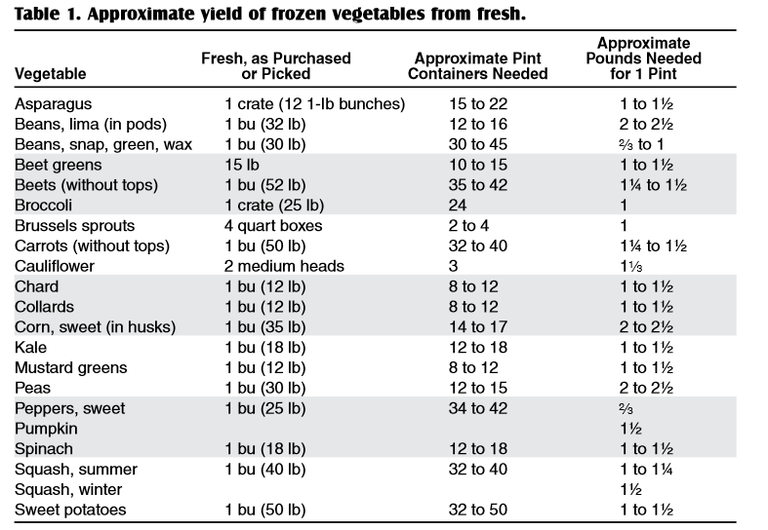
To Blanch in Boiling Water
Use a blancher that has a blanching basket and cover or fit a wire basket into a large kettle with a cover. A cheesecloth bag is another option. Use at least 1 gallon of water for each pound of vegetables. Put the vegetables into the basket or bag and lower the basket into the boiling water. Cover and start counting time immediately. Keep heat high and continue boiling for the time specified for the vegetable you are freezing. If boiling stops, you are blanching too large a quantity at one time.
The same water can be reused several times for blanching; just be sure to bring it back to a vigorous boil before adding vegetables.
To Blanch in Steam
Put 1 to 2 inches of water in a kettle and bring to a rolling boil. Suspend a thin layer of vegetables in a wire basket or cheesecloth over the rapidly boiling water. Cover, keep the heat on high, and steam blanch vegetables the time recommended in the table.
Blanching in the Microwave
Microwave-blanched vegetables are not as acceptable as either water- or steam-blanched vegetables. Using the microwave for vegetable blanching does not save significant time. This is because the time required when using either water or steam is so short.
If you choose to use the microwave for blanching vegetables, check the oven manufacturer’s recommendations.
Cooling
After vegetables are heated they should be cooled quickly and thoroughly to stop the cooking. After heating, plunge the basket of vegetables immediately into a large quantity of cold water. Change water frequently or use cold running water or ice water. If ice is used you’ll need about 1 pound of ice for each pound of vegetables. It takes about as long to cool the vegetables as it does to heat them. When vegetables are cool, remove from water and drain thoroughly.
■ Methods of Packing Vegetables
When using rigid containers leave head space (see below). Food expands when it freezes, and the top may pop off the container if it is too full.
When using freezer bags, press air out of unfilled part of the bag, seal and freeze. If the bag has a twist closure, be sure to twist the bag and fold the bag back in a gooseneck before securing the twist. If this is not done, air will rush back into the bag.
Vegetables can be packed either solid or loose.
Solid pack: Put drained vegetables into freezer containers. Pack tightly to cut down on the amount of air in the container or bag. Seal and freeze.
Loose or tray pack: This enables you to pour out as much as you want from a large package. Spread the drained vegetables in a single layer on a tray and freeze. As soon as they are frozen, pour into rigid freezer containers or bags, seal and return to freezer. Remove as you need them.
■ How to Use Frozen Vegetables
Most frozen vegetables should be cooked without thawing them first. Corn on the cob is an exception — it should be partially thawed so the cob is heated through by the time the corn is cooked. This takes about 10 minutes.
Do not overcook vegetables. Cook only until tender. Most vegetables have been partially cooked when blanched, so less cooking time is required than for fresh vegetables. Cook in a small amount of water; about ½ cup is sufficient.
Note: The microwave oven does an excellent job of cooking frozen vegetables. Follow the manufacturer’s recommendations for times and power selections.
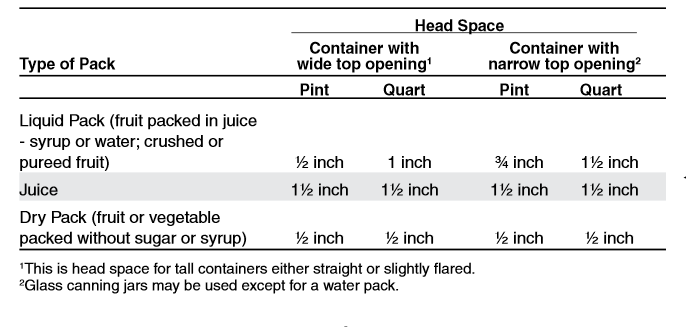
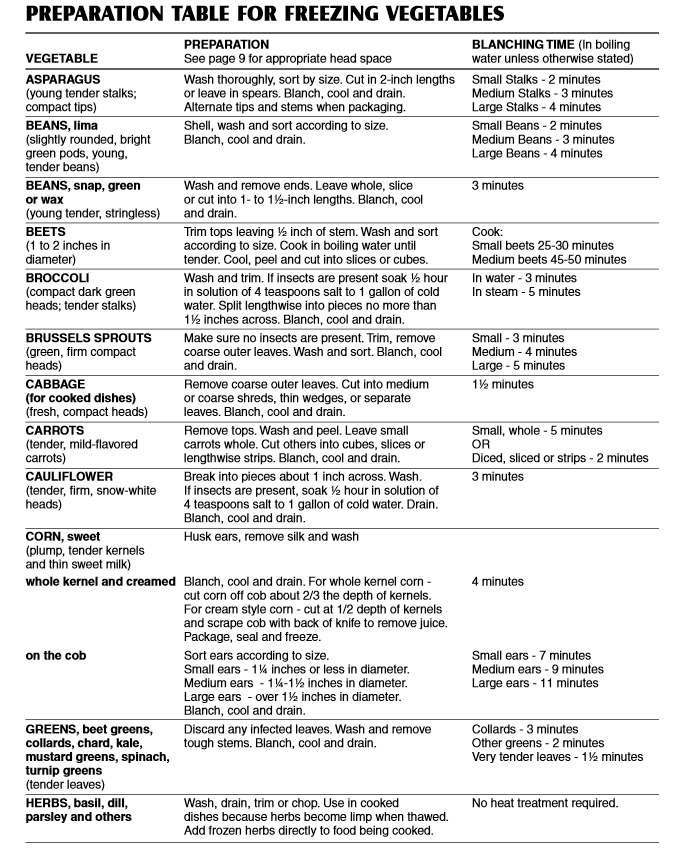
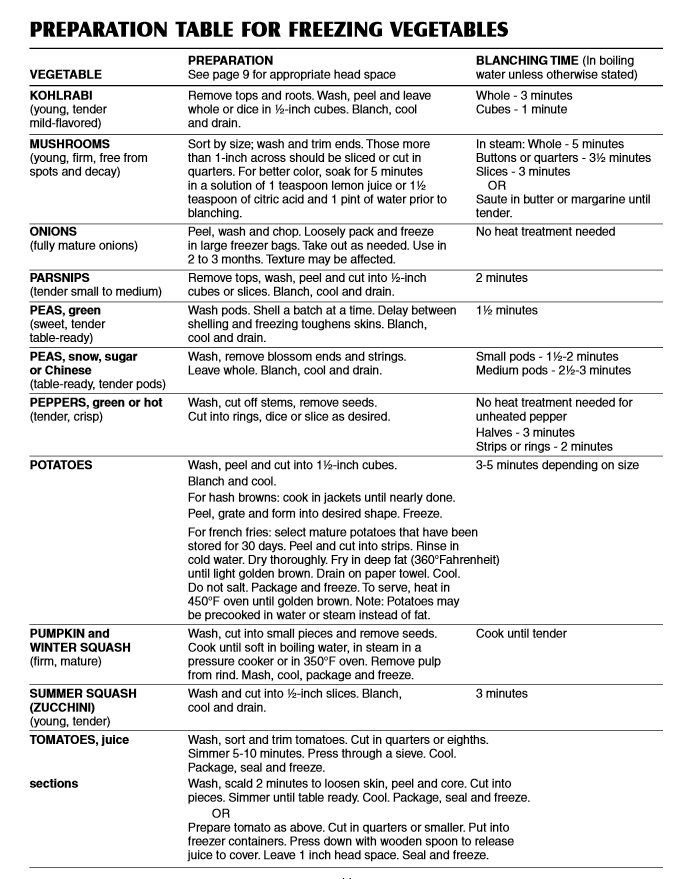
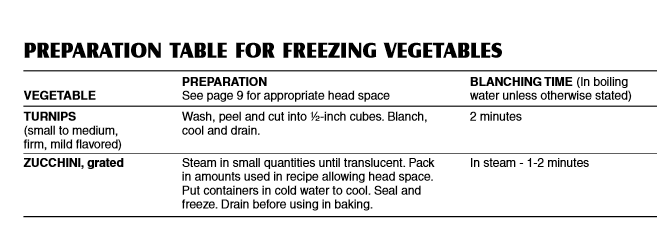
■ Freezing Fruits
Most fruits can be frozen satisfactorily, but the quality of the frozen product will vary with the kind of fruit, stage of maturity and type of pack.
Select a variety suitable for freezing. Select fruits with a firm texture and well-developed flavor and treat them with respect. Wash small lots (2 to 3 quarts) at a time to avoid bruising. Wash through several changes of cold water, lifting produce out of the water so dirt will not settle back on the fruit. Do not let produce soak.
Fruits are prepared for freezing in about the same way as for serving. It is best to prepare enough fruit for only 2 to 3 quarts at one time.
If fruit is to be crushed, suit the method to the fruit. A wire potato masher, pastry fork or slotted spoon may be used to crush soft fruits. Firm fruits may be crushed more easily with a food chopper. A colander, food press or strainer is useful for making purees. Blenders and food processors tend to liquify the fruit too much.
Do not use galvanized ware with fruit or fruit juices because the acid in fruit dissolves the zinc, which is poisonous. Metallic off-flavors may result from the use of iron utensils, chipped enameled ware or tinware that is not well tinned.
Preventing discoloration
Some fruits such as peaches, apples, pears and apricots darken quickly when exposed to air and during freezing.
While preparing, keep peeled, halved, quartered, sliced or diced fruits that turn dark in a solution of ascorbic acid. This procedure is also useful for preventing stem-end discoloration in cherries and grapes. You can get ascorbic acid in several forms:
Pure powdered form — seasonally available among canners’ supplies in supermarkets. One level teaspoon of pure powder weighs about three grams. Use one teaspoon per gallon of water as a treatment solution.
Vitamin C tablets — economical and available year round in many stores. Buy 500-milligram tablets; crush and dissolve six tablets per gallon of water as a treatment solution.
Commercially prepared mixes of ascorbic and citric acid — seasonally available among canners’ supplies in supermarkets. Citric acid powder is sold in supermarkets, but it is less effective in controlling discoloration. If you choose to use these products, follow the manufacturer’s directions.
Choosing a pack
There are several types of fruit packs suitable for freezing: syrup pack, sugar pack, unsweetened pack, tray pack or sugar replacement pack.
Most fruits have a better texture and flavor if packed in sugar or syrup. Some can be satisfactorily packed without sweetening, but vitamin C losses are greatest when fruits are packed without sugar. The type of pack will depend on the intended use. Fruits packed in syrup are generally best for serving uncooked; those packed in dry sugar or unsweetened are best for most cooking purposes because there is less liquid in the product. Unsweetened packs and sugar replacement packs are often used by people on special diets.
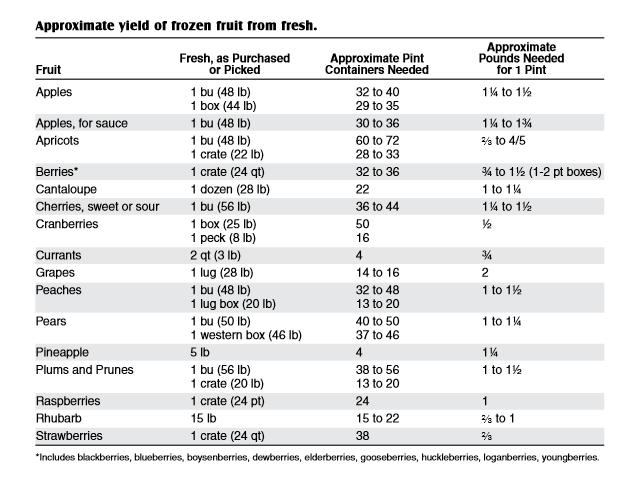
Syrup pack
The proportion of sugar to water used depends on the sweetness of the fruit and the taste preference of the user. A 40 percent syrup is recommended for most fruits. Lighter syrups are desirable for mild flavored fruits to prevent masking the flavor. Heavier syrups may be used for very sour fruits.

To make syrup, dissolve the sugar in lukewarm water until the solution is clear. Cool syrup before using.
Use just enough cold syrup to cover the prepared fruit after it has been settled by jarring the container (about 1/2 to 3/4 cup of syrup per pint). To keep the fruit under the syrup, place a small piece of crumpled waxed paper or other water resistant wrapping material on the top and press the fruit down into the syrup before closing, sealing and freezing.
Unsweetened pack
Fruit can be packed dry. Place the clean fruit in the carton, cover and freeze, or cover with water containing ascorbic acid or packed in unsweetened juice. For fruit packed in water or juice, submerge fruit by using a small piece of crumpled water-resistant material as for syrup and sugar packs. Seal tightly and freeze.
Unsweetened packs generally yield a lower quality product than packs with sugar. However, some fruits such as raspberries, blueberries, scalded apples, gooseberries, currants, cranberries and rhubarb give a good quality without sugar.
Sugar pack
Put fruit in a bowl or shallow pan. Sprinkle sugar over the fruit and mix gently until the juice is drawn out and the sugar is dissolved. Use a large spoon or pancake turner for mixing.
Soft sliced fruits, such as peaches, strawberries, plums and cherries will yield sufficient syrup for covering if the fruit is layered with sugar and allowed to stand for 15 minutes. Some whole fruits may be coated with sugar and frozen.
Pack fruit and juice into container. Place a small piece of crumpled water-resistant paper on top to hold fruit down in the juice. Seal and freeze.
Tray pack
This is a good pack for the fruits mentioned above in unsweetened pack section. Spread a single layer of prepared fruit on shallow trays. Freeze and package in freezer bags promptly. The fruit pieces remain loose. Later the bag may be opened, the needed amount taken out, and the bag reclosed and returned to the freezer.
Sugar replacement pack
Sugar substitutes can be used when freezing fruits. They will give a sweet taste but do not furnish the beneficial effects of sugar like color protection and thick syrup. Fruits frozen with sugar replacements will freeze harder and thaw more slowly than those preserved with sugar.
Follow directions on the label of the sweetener to determine the amount of sweetener needed. Non-sugar sweeteners can be added at serving time instead of during the freezing process.
■ Packing
Use containers designed for freezer use. Allow head space between packed food and closure because most fruits expand during freezing. See page 9 for amount of head space needed.
■ Thawing Fruits
Allow fruit to thaw in the unopened package. Fruits packed in dry sugar thaw faster than those in syrup. Fruits packed without sugar take longer to thaw. Fruit to be served in salads, shortcakes, fruit sauce and fruit cups should be only partially thawed. Thaw fruits for pies until able to separate. Completely thawed fruit will become soft and may darken upon standing.
■ Preparation of Fruits for Freezing
Apples
Apple slices – Select firm, crisp full-flavored apples. Wash, peel and core. Slice medium apples into twelfths, large sizes into sixteenths. Pack in one of the following ways.
Syrup pack – Use 40 percent syrup. For a better quality frozen product add ½ teaspoon crystalline ascorbic acid to each quart of syrup.
Slice apples directly into cold syrup in containers, starting with ½ cup syrup to a pint container. Press fruit down in containers and add enough syrup to cover.
Leave head space. Seal and freeze.
Sugar pack – To prevent darkening of apples during preparation, slice them into a solution of 2 tablespoons salt to a gallon of water. Hold in this solution not more than 15 to 20 minutes. Drain.
To retard darkening, place slices in a single layer in steamer; steam 1½ to 2 minutes, depending on thickness of slice. Cool in cold water and drain.
Over each quart (1¼ pounds) of apples slices evenly sprinkle ½ cup sugar and stir.
Pack apples into containers and press fruit down. Leave head space. Seal and freeze.
Unsweetened pack – Follow directions for sugar pack, omitting sugar.
For pies – Follow directions for sugar pack, omitting sugar. Arrange steamed slices in a pie plate as for a pie. Put the filled plate into a plastic bag and freeze. Remove the solid chunk of slices from the plate as soon as frozen. Wrap it tightly and return to the freezer. At pie-making time, lay the pie-shaped chunk of slices in your pastry. Put on the sugar and seasonings, top with a crust and bake.
Applesauce – Select full-flavored apples. Wash apples, peel if desired, core and slice. To each quart of apple slices add a cup water and cook until tender. Puree and add ¼ cup sugar, if desired, for each quart of hot puree, stirring until dissolved. Cool and package leaving head space). Seal and freeze.
Apple juice – Place freshly made juice in rigid containers. Leave head space. Seal and freeze.
Apricots
Halved – Select firm, ripe, uniformly yellow apricots. Sort, wash, half and pit. Peel and slice if desired. Unpeeled apricots are satisfactory for pies.
If apricots are not peeled, heat them in boiling water ½ minute to keep skins from toughening during freezing. Then cool in cold water and drain.
Pack into containers in one of the following ways.
Syrup pack – Use 40 percent syrup. For a better quality frozen product, add ¾ teaspoon crystalline ascorbic acid to each quart of syrup.
Pack apricots directly into containers. Cover with syrup. Leave head space. Seal and freeze.
Sugar pack – Before combining apricots with sugar, treat the fruit as follows to prevent darkening:
Dissolve ¼ teaspoon crystalline ascorbic acid in ¼ cup water and sprinkle over 1 quart (7/8 pound) of fruit.
Mix ½ cup sugar with each quart of fruit. Stir until sugar is dissolved. Pack apricots into containers and press down until fruit is covered with juice, leaving head space. Seal and freeze.
Crushed or puree – Select fully ripe fruit. For crushed apricots, dip in boiling water for ½ minute and cool in cold water. Peel the apricots. Pit and crush them coarsely.
For puree, pit and quarter the apricots. Press through a sieve; or heat to boiling point in just enough water to prevent scorching and then press through a sieve.
With each quart (2 pounds) of prepared apricots mix with 1 cup sugar. For a better product, add to the fruit ¼ teaspoon cyrstalline ascorbic acid dissolved in ¼ cup of water just before adding the sugar.
Pack into containers, leaving head space. Seal and freeze.
Avocados
Select avocados that yield to gentle pressure with rind free from dark blemishes. Peel fruit, cut in half and remove pit.
Puree – Mash. Add ¼ teaspoon crystalline ascorbic acid to each quart of puree or add 1 tablespoon lemon juice for each two avocados. Use the ascorbic acid if intended use is in a sweet dish. Use lemon juice if for Guacamole. Pack into containers, leaving head space (page 9). Seal and freeze.
Bananas
Select firm ripe bananas. Peel. Mash thoroughly while adding 1 teaspoon lemon juice per cup of mashed banana. Pack, leaving head space (page 9). Seal and freeze.
Berries, most firm
(blueberries, elderberries, huckleberries)
Whole – Select full-flavored, ripe berries all about the same size, preferably with tender skins. Sort, wash and drain.
If desired, steam for 1 minute and cool immediately. Preheating in steam tenderizes skin and makes a better flavored product.
Use one of the following packs.
Syrup pack – Pack berries into containers and cover with cold 40 percent syrup. Leave head space. Seal and freeze.
Unsweetened pack – Tray pack or pack berries into containers, leaving head space. Seal and freeze.
Crushed or puree – Select fully ripened berries. Sort, wash and drain. Crush, or press berries through a fine sieve for puree.
To 1 quart (2 pounds) crushed berries or puree, add 1 to 1c cups sugar, depending on tartness of fruit. Stir until sugar is dissolved. Pack into containers, leaving head space. Seal and freeze.
Berries, most soft
(blackberries, boysenberries, dewberries, loganberries, young berries)
Select firm, plump, fully ripe berries with glossy skins. Green berries may cause off-flavor.
Sort and remove any leaves and stems. Wash and drain.
Use one of the following packs.
Syrup pack – Pack berries into containers and cover with cold 40 or 50 percent syrup, depending on the sweetness of the fruit. Leave head space. Seal and freeze.
Sugar pack – To 1 quart (1 1/3 pounds) berries, add ¾ cup sugar. Turn berries over and over until most of the sugar is dissolved. Fill containers, leaving head space. Seal and freeze.
Unsweetened pack – Pack berries into containers, leaving head space. Seal and freeze.
Crushed or puree – Prepare for packing in the same way as whole berries. Then crush, or press through a sieve or puree.
To each quart (2 pounds) of crushed berries or puree add 1 cup sugar. Stir until sugar is dissolved. Pack into containers, leaving head space. Seal and freeze.
Cherries, sour
Select bright red, tree-ripened cherries. Stem, sort and wash thoroughly. Drain and pit.
Use one of the following packs:
Syrup pack – Pack cherries into containers and cover with cold 60- or 65-percent syrup (page 13), depending on tartness of the cherries. Leave head space. Seal and freeze.
Sugar pack – To 1 quart (1a pounds) cherries add ¾ cup sugar. Mix until sugar is dissolved. Pack into containers, leaving head space. Seal and freeze.
Cherries, sweet
Select well-colored, tree-ripened fruit with a sweet flavor. Sort, stem, wash and drain. Remove pits if desired — they tend to give an almond-like flavor to the fruit.
Pack cherries into containers. Cover with cold 40 percent syrup to which ½ teaspoon crystalline ascorbic acid has been added per quart. Leave head space. Seal and freeze.
With sour cherries, use half sweet cherries and half sour cherries. Pack as above using 50 percent syrup. Ascorbic acid may be added, but is not as essential as it is for sweet cherries alone.
Cranberries
Whole – Choose firm, deep red berries with glossy skins. Stem and sort. Wash and drain.
Unsweetened pack – Tray pack or pack into containers without sugar. Leave head space. Seal and freeze.
Syrup pack – Pack into containers. Cover with cold 50 percent syrup. Leave head space. Seal and freeze.
Puree – Prepare cranberries as for freezing whole. Add 2 cups water to each quart (1 pound) of berries. Cook until skins have popped. Press through a sieve.
Add sugar to taste, about 2 cups for each quart (2 pounds) of puree. Pack into containers, leaving head space (page 9). Seal and freeze.
Gooseberries
Choose fully ripe berries if freezing for pie — berries a little underripe for jelly making. Sort, remove stems and blossom ends, and wash.
Unsweetened pack – Tray pack or pack into containers without sugar. Leave head space. Seal and freeze.
Syrup pack – Pack into containers. Cover with 50 percent syrup. Leave head space: Seal and freeze.
Grapefruits, Oranges
Sections or slices – Select firm tree-ripened fruit heavy for its size and free from soft spots. Wash and peel. Divide fruit into sections, removing all membranes and seeds. Slice oranges if desired. For grapefruit with many seeds, cut fruit in half, remove seeds and cut or scoop out sections.
Pack fruit into containers. Cover with cold 40 percent syrup made with excess fruit juice and water if more liquid is needed. For better quality, add ½ teaspoon crystalline ascorbic acid to each quart of syrup. Leave head space. Seal and freeze.
Juice – Select fruit as directed for sections. Squeeze juice from fruit, using squeezer that does not press oil from rind.
Sweeten, if desired, with 2 tablespoons sugar for each quart of juice, or pack without sugar. For better quality, add ¾ teaspoon crystalline ascorbic acid for each gallon of juice. Pour juice into containers immediately. To avoid development of off-flavors, pack juice in glass jars. Leave head space. Seal and freeze.
Ground cherries
Husk. Scald for 2 minutes. Pack in 40 percent syrup. Leave head space. Seal and freeze.
Melons (cantaloupe, crenshaw, honeydew, Persian, watermelon)
Syrup pack – Select firm-fleshed, well-colored, ripe melons. Cut in half, remove seeds and peel. Cut melons into slices, cubes or balls. Pack into containers and cover with cold 30 percent syrup. Leave head space. Seal and freeze.
Unsweetened pack – Select and prepare as for syrup pack. Place in freezer bag. Seal and freeze. Serve before completely thawed.
Nectarines
Halves, quarters or slices – Choose fully ripe, well-colored, firm nectarines. Overripe fruit may take on a disagreeable flavor in frozen storage.
Sort, wash and pit the fruit. Peel if desired. Cut in halves, quarters or slices.
Cut fruit directly into cold 40 percent syrup, starting with ½ cup for each pint container. For a better product add ½ teaspoon crystalline ascorbic acid to each quart of syrup. Press fruit down and add syrup to cover, leaving head space. Seal and freeze.
Puree – Prepare same as peach puree below.
Peaches
Halves and slices – Peaches in halves and slices have better quality when packed in syrup or with sugar, but a water pack will serve if sweetening is not desired.
Select firm, ripe peaches with no green color in the skins.
Sort, wash, pit and peel. For a better product, peel peaches without a boiling-water dip. Slice if desired.
Syrup pack – Use 40 percent syrup. For a better quality product, add ½ teaspoon crystalline ascorbic acid for each quart of syrup.
Put peaches directly into cold syrup in container, starting with ½ cup syrup to a pint container. Press fruit down and add syrup to cover, leaving head space. Seal and freeze.
Sugar pack – To each quart (1 1/3 pounds) of prepared fruit add b cup sugar and mix well. To retard darkening, sprinkle ascorbic acid dissolved in water over the peaches before adding sugar. Use ¼ teaspoon crystalline ascorbic acid in ¼ cup cold water to each quart of fruit.
Pack into containers, leaving head space. Seal and freeze.
Water pack – Pack peaches into containers and cover with cold water containing 1 teaspoon crystalline ascorbic acid to each quart of water. Leave head space. Seal and freeze.
Puree – To loosen skins, dip peaches in boiling water ½ to 1 minute. The riper the fruit, the less scalding needed. Cool in cold water, remove skins and pit.
To puree, press through a sieve, or heat pitted peaches 4 minutes in enough water to prevent scorching and press through a sieve.
With each quart (2 pounds) of pureed peaches mix 1 cup sugar. For better quality, add 1c teaspoons crystalline ascorbic acid to each quart of fruit.
Pack into containers, leave head space. Seal and freeze.
Pears
Halves or quarters – Select pears that are well ripened and firm, but not hard. Wash fruit in cold water. Peel, cut in halves or quarters and remove cores.
Heat pears in boiling 40 percent syrup for 1 to 2 minutes, depending on size of pieces. Drain and cool.
Pack pears into containers and cover with cold syrup. For a better product, add ¾ teaspoon crystalline ascorbic acid to a quart of cold syrup. Leave head space. Seal and freeze.
Pineapple
Select firm, ripe pineapples with full flavor and aroma. Pare and remove core and eyes. Slice, dice, crush, or cut the pineapple into wedges or sticks.
Unsweetened pack – Pack fruit tightly into containers without sugar. Leave head space. Seal and freeze.
Syrup pack – Pack fruit tightly into containers. Cover with 30 percent syrup made with pineapple juice, if available, or with water. Leave head space. Seal and freeze.
Plums and prunes
Whole, halves or quarters – Choose firm tree-ripened fruit of deep color. Sort and wash. Leave whole or cut in halves or quarters. Pack in one of the following ways.
Unsweetened pack – Pack whole fruit into containers, leaving head space. Seal and freeze.
To serve uncooked, dip frozen fruit in cold water for 5 to 10 seconds, remove skins, and cover with 40 percent syrup to thaw.
Syrup pack – Pack cut fruit into containers. Cover fruit with cold 40 or 50 percent syrup, depending on tartness of fruit. For improved quality, add ½ teaspoon crystalline ascorbic acid to a quart of syrup. Leave head space. Seal and freeze.
Raspberries
Whole – Select fully ripe, juicy berries. Sort, wash carefully in cold water and drain thoroughly.
Sugar pack – To 1 quart (1 1/3 pounds) berries add ¾ cup sugar and mix carefully to avoid crushing. Put into containers, leaving head space. Seal and freeze.
Syrup pack – Put berries into containers and cover with cold 40 percent syrup, leaving head space . Seal and freeze.
Unsweetened pack – Put berries into containers, leaving head space. Seal and freeze.
Crushed or puree – Prepare as for whole raspberries then crush or press through a sieve for puree.
To 1 quart (2 pounds) crushed berries or puree add ¾ to 1 cup sugar, depending on sweetness of fruit. Mix until sugar is dissolved. Put into containers, leaving head space. Seal and freeze.
Rhubarb
Stalks or pieces – Choose firm, tender, well-colored stalks with good flavor and few fibers. Wash, trim and cut into 1 or 2 inch pieces or in lengths to fit the package. Heating rhubarb in boiling water for 1 minute and cooling promptly in cold water helps retain color and flavor.
Unsweetened pack – Tray pack or pack either raw or preheated rhubarb tightly into containers without sugar. Leave head space. Seal and freeze.
Pie pack – Use directions give for apples.
Syrup pack – Pack either raw or preheated and cooled rhubarb tightly into containers, cover with cold 40 percent syrup. Leave head space . Seal and freeze.
Sugar pack – Mix either raw or preheated and cooled rhubarb with ½ cup sugar per quart of prepared fruit. Pack, leaving head space. Seal and freeze.
Strawberries
Whole – Choose firm, ripe, red berries preferably with a slightly tart flavor. Large berries are better sliced or crushed. Sort berries, wash them in cold water, drain well and remove hulls.
Syrup packed – Put berries into containers and cover with cold 50 percent syrup, leave head space. Seal and freeze.
Sugar packed – Add ¾ cup sugar to 1 quart (1 1/3 pounds) strawberries and mix thoroughly. Put into containers, leaving head space. Seal and freeze.
Unsweetened pack – Tray pack or pack into containers, leaving head space. For better color, cover with water containing 1 teaspoon crystalline ascorbic acid to each quart of water. Seal and freeze.
Sliced or crushed – Prepare for packing as for whole strawberries, then slice, or crush partially or completely.
To 1 quart (1½ pounds) berries add ¾ cup sugar; mix thoroughly. Pack into containers, leaving head space. Seal and freeze.
Puree – Prepare strawberries as for freezing whole. Then press berries through a sieve. To 1 quart (2 pounds) puree add b cup sugar and mix well. Put into containers, leaving head space. Seal and freeze.
■ Freezing Prepared Foods
For success use only high-quality foods and ingredients that freeze well. Package properly, store at 0°F or lower, and use within recommended storage time. If you are uncertain about how a prepared food freezes, try freezing a small portion to see if the quality is acceptable.
Reasons for Freezing Prepared Foods
- Waste can be avoided by freezing leftovers.
- Time can be saved by doubling or tripling recipes and freezing the extra.
- Foods can be prepared when the time is available.
- Foods can be prepared when in season or on special.
- If cooking for one or two, individual portions can be frozen for later use.
Points to Remember
- Expect some changes in seasoning level of frozen dishes. Season sparingly and season to taste when reheated.
- Add crumb or cheese toppings just before reheating. These tend to get soggy or dry when frozen.
- A general suggestion is to slightly undercook foods to allow for additional cooking when reheating. Some experimenting may be necessary.
- Quickly cool foods to be frozen by placing container of hot food in a pan or sink of ice water.
- Package foods in practical meal-size quantities in appropriate freezer material (see pages 21-22).
- Baking dishes may be lined with foil or plastic wrap, the food frozen in them, and then removed and properly wrapped for freezer storage (see page 22, casserole wrap).
■ Freezing Animal Products
Meat, Poultry and Fish
Freezing is the best way to retain the good taste and texture of meat, poultry and fish.
PLANS FOR FREEZING
- Examine the household’s needs and usage. For top quality, meats should be used within recommended storage times.
- Consider the amount of freezing space one wishes to devote to these foods. A cubic foot of freezer space will hold 30 to 35 pounds of meat.
- Shop for specials and take advantage of seasonal peaks.
- Processed cured meats such as ham and bacon should be frozen for only 1 to 3 months because the high salt and fat content accelerate rancidity.
GENERAL TIPS FOR SUCCESSFUL FREEZING
- Freeze meat as soon as desirable after slaughter and as soon as possible after purchase to ensure freshness and top quality.
- Trim excess fat and remove bones if practical, or cover sharp extruding bones with folded freezer paper or foil so they will not pierce the outside wrapper.
- Freeze meat in meal-size pieces and packages. Place a double layer of freezer wrap between individual pieces.
- Do not season meat before freezing for longest freezer life.
- Meatballs, beef cubes, chops or meat patties can be tray frozen (see page 14) then packaged in freezer bags.
- Materials used for packaging meat, fish and poultry need to have the same characteristics as those used for freezing other foods (see page 3).
- Packages must be air tight to maintain quality.
- The store wrap on meats from self-service counters is not meant for freezer storage longer than two weeks. Rewrap or over wrap for longer storage.
- Wrap used by butchers may be either coated or uncoated. The coated is suitable for use in the freezer, but the uncoated is unsatisfactory.
- Vacuum-packaged meats can be frozen in the undamaged package for one to three months.
PACKAGING
Red Meats
Freezer bags or containers may be used for freezing ground meats, stew meats or other meats frozen into small portions.
Meats can be wrapped using either the drugstore or the butcher wrap (see pages 23-24). The drugstore wrap is preferred, except for irregular meat cuts. The butcher wrap is more appropriate for these.
Lard
Freezing helps prevent rancidity. Use glass jars or plastic containers. Make an airtight seal.
For extra protection against rancidity, obtain a commercial antioxidant from a locker plant or a drugstore. Use it according to the manufacturers directions or add fresh hydrogenated vegetable fat to the rendered lard using this proportion: 2 to 3 pounds of vegetable fat to 50 pounds lard. Mix thoroughly while still hot. Pour into small containers, filling to the top.
■ METHODS OF WRAPPING
Drugstore Wrap
Cut off enough wrapping material to wrap around the food about 1½ times or enough to make three 1-inch fold down when wrapping.
- Place meat in center of wrapping.
- Bring two opposite edges of the wrap together centered above food.
- Fold the edges down in a series of folds ½ to 1 inch deep until the fold lies against the food.
- Press the fold down across the food, squeezing out the air.
- Turn package over. Press ends to remove air.
- Fold ends snugly with a double fold.
- Bring ends up and fasten securely with cord or freezer tape. Label.
Butcher Wrap
Best for bulky and irregular shaped foods. Cut off enough wrap to go around the food twice.
- Place food at one corner of the wrapping.
- Fold the food and wrap over two times in the direction of the opposite corner.
- Fold the ends up pushing the air out as you fold.
- With ends tucked up, continue to fold food and wrapping over.
- Pull end tight and seal with cord or freezer tape. Label.
Casserole Wrap
Allows for reuse of baking dish after food is frozen.
- Line baking dish with heavy duty foil*, leaving a 1½ inch foil collar around the edge.
- Place food in foil-lined dish. Cover with sheet of foil the size of dish and foil collar. Press air out from center; fold edges together, sealing tightly.
- Label and freeze. When frozen, lift from dish and return food to freezer.
*You can use a plastic-type freezer wrap can be used to line baking dishes. The wrap needs to be large enough to fold over the top for sealing.
Bundle Wrap
Good for odd shapes and semimoist foods. Foods may be baked or grilled in this wrap.
- Center food on a square of heavy duty foil large enough for adequate wrapping.
- Bring four corners of foil up together in a pyramid shape.
- Fold open edges together in locked folds, pressing air out, until foil is tight against food. Label.
■ POULTRY
Chill home-slaughtered poultry in the refrigerator below 40 F, 6 hours for broiler-fryers and 24 hours for older birds. If refrigerator space is not available it can be chilled for two to three hours in a large tub of ice water.
Packaging
Wrap giblets separately from bird. Arrange poultry to give a compact, flat package. Tie the wings and legs closely to the body on birds frozen whole.
Poultry may be wrapped in freezer wrap or placed in freezer bags. Remove as much air as possible. Plastic freezer bags conform to the irregular shape of poultry. A good way to remove air is to place the bird in the bag and then plunge the bag in a pan of cold water. This forces
air to the top. Quickly twist the top in a goose neck and secure. Dry bag thoroughly.
Warning: Do not stuff birds before freezing. The time the stuffing takes to cool in the bird before freezing and to thaw and reheat it may be long enough to permit growth of food spoilage and food poisoning bacteria.
Pink Meat - Dark Bones
Sometimes the meat around bones of young fryers or broilers looks pink or raw even though thoroughly cooked. This color is thought to come from hemoglobin in the bones of young birds. It usually shows up more with long, slow cooking or in chicken that has been frozen. The meat is safe to eat.
Bones in cooked chicken sometimes become a dark maroon color. This color usually shows up more in frozen chicken and is due to hemoglobin. It does not affect the safety of the chicken.
■ FISH
Improperly frozen fish develops a bad taste and becomes dry and tough. A number of alternative methods are available for freezing fish properly.
Keep fresh fish as cold as possible. Clean them immediately and freeze at once.
Clean fish as for immediate use. Wash thoroughly. If slime is a problem, rinse fish in a solution of one teaspoon vinegar to three quarts of cold water.
Leave the fish whole or in large pieces if it is going to be stored longer than three months.
Pretreating
Fish are categorized as either fat or lean. Fat fish include mullet, mackerel, trout, tuna, salmon and whitefish. Lean fish include flounder, cod, whiting, snapper and most freshwater fish.
Pretreating before freezing improves the quality of fish stored for more than four to six months.
Place fat fish in an ascorbic acid dip for 20 seconds (2 tablespoons ascorbic acid to 1 quart cold water) to decrease rancidity and flavor change. Wrap and freeze immediately.
Immerse lean fish in a chilled salt brine of ¼ cup salt to 1 quart water for 20 minutes. This treatment firms the fish and reduces drip loss when thawed.
Packaging
One of the best methods is to wrap fish with a cling plastic wrap and then overwrap with a freezer wrap. Squeeze out as much air as possible.
Fish may be placed in freezer bags. Submerge the bag in a pan of cold water to force the air out. Do not let water flow into the bag. Seal the bag by twisting and a goose neck.
■ ALTERNATIVE FREEZING METHODS
Glazes
Ice - Freeze unwrapped fish. Then dip frozen fish in near-freezing ice water and return to freezer. Repeat this sequence until the glaze is c to ¼ inch thick. Be careful not to break the glaze when handling the fish. Wrap glazed fish for storage.
Gelatin
To prepare the glaze:
- Measure ¼ cup of lemon juice into a pint container. Fill the rest of the container with water.
- Dissolve one packet of unflavored gelatin in ½ cup of the lemon juice-water mixture.
- Heat the remaining liquid to boiling.
- Stir the dissolved gelatin mixture into the boiling liquid.
- Cool the mixture to room temperature.
Dip the fish into the glaze and drain it for several seconds. The glaze will be enough for about a dozen medium-size fillets. Wrap glazed fish and freeze.
Water
Place fish in a container and cover with water. Too much water and large containers will draw out nutrients, cause fish to freeze slowly, and cause a soft texture in the fish because of pressure from the ice.
You should freeze fish first and then add cold water and freeze again. This hastens freezing and reduces pressure on the fish flesh.
Smoked fish may be refrigerated for two to three weeks. Do not store smoked fish in airtight containers in the refrigerator. For longer storage, the fish may be frozen immediately after smoking. Use within three months. Use within a few days after thawing.
Shrimp can be frozen, cooked or raw, with shells on or off. For maximum storage life and quality freeze shrimp raw with head and dark vein removed, but shells still on. Shrimp may be placed in a shallow pan, covered with water, frozen and wrapped.
Be sure to wash and drain shrimp if frozen uncooked. Quickly chill cooked shrimp.
Oysters should be fresh and live. Shuck oysters and wash meat in fresh salted water (½ cup salt to 1 gallon cold water). Drain, package and freeze.
■ THAWING AND PREPARING - Meat, Fish & Poultry
Frozen meats, poultry and fish are best when thawed in the refrigerator in their original wrapping on the lowest shelf in a container. For faster thawing, place the meat or fish in a waterproof wrapping in cold water. Change the water as needed so it stays cold. You can thaw these foods in a microwave oven. For best quality, cook thawed meat and fish immediately.
You can cook meat, poultry and fish from the frozen state, but you must allow additional cooking time. The amount of additional time depends on the size and shape of the product. Large frozen roasts can take 1½ times as long. Small pieces of frozen fish may take twice as long to cook as fresh or thawed.
When you plan to bread and fry frozen meat, poultry or fish, they should be at least partially thawed first for easier handling. All poultry to be stuffed should be thawed completely for safety.
■ DAIRY PRODUCTS
Butter - Freeze only high-quality butter made from pasteurized cream. Over-wrap store wrap with freezer wrapping. Unsalted butter loses flavor so its storage time is shorter. Flavored butter freezes well.
Cheese - Hard or semi-hard cheeses can be frozen. Frozen cheese will be crumbly and a little dry and will not slice as well, but the flavor will be just as good as fresh cheese. Freeze cheese in small pieces — no more than ½ pound per chunk. Seal it in foil, freezer wrap, plastic film or bag.
Cottage cheese - Cream style and dry cottage cheese and ricotta cheese can be frozen for a month. Cream style may separate when thawed.
Cream cheese - can be frozen for later use in cooking, dips or as icing.
Cheese food products, such as sauces, dips, processed cheese — flavored or plain — usually freeze fine. If in real doubt, freeze a small quantity and check after 24 hours by thawing it. If pleased with the results, freeze the rest. Otherwise, do not freeze.
Cream - Freeze only heavy cream containing 40 percent or more butter fat. Lighter cream and half and half do not freeze well. Cream that has been frozen will not whip to the usual volume. Whipped cream can be sweetened to taste and frozen in individual sized portions. Tray-freeze in mounds.
Ice cream - A plastic wrap laid tightly on the surface of partially used containers of ice cream helps prevent surface changes. Homemade ice cream is difficult to store for any length of time because it becomes grainy. Commercial products have added milk solids and gelatin to prevent this.
Milk - Pasteurized homogenized milk may be frozen, including low and non-fat. Some quality change may be noted upon thawing. Stirring or shaking may help restore smoothness.
Sour cream, yogurt and buttermilk - All of the cultured, soured dairy products lose their smooth texture when frozen. They become grainy and sometimes separate out their water. They can still be used for cooking. Flavored yogurts may be more stable because of the fruit and sugar. It may taste more acidic when thawed.
■ EGGS
Eggs can be stored for at least one month, covered in the refrigerator. Freezing is often unnecessary.
Whole Eggs - Thoroughly mix yolks and whites. Do not whip in air. To prevent graininess, add 1 tablespoon sugar or ½ teaspoon salt per cup whole eggs, depending on intended use. Strain through a sieve or colander to improve uniformity. Package, allowing ½ inch head space. Seal and freeze.
Another method of freezing whole egg mixture is to use ice trays. Measure 3 tablespoons of egg mixture into each compartment of an ice tray. Freeze until solid. Remove frozen cubes, and package in moisture/vapor resistant containers. Seal and freeze. Three tablespoons of the egg mixture equals one whole egg.
Egg Yolks - Separate eggs. Stir gently. To prevent graininess, add 2 tablespoons sugar or 1 teaspoon salt per cup of egg yolks, depending on intended use. Strain through a sieve. Package, allowing ½ inch head space. Seal and freeze. One tablespoon of the yolk mixture equals one egg yolk.
Egg Whites - Gently mix whites. Strain through a sieve. Package, leaving ½ inch head space. Seal and freeze. Two tablespoons of the egg white mixture equals one egg white.
■ Thawing Dairy Products and Eggs
Butter, eggs, milk, cream and cheese - Place the frozen product in the refrigerator to thaw. After thawing use as fresh. Use soon after thawing. Do not refreeze.
You may need to be mix or blend cream and milk slightly.
■ EXTRA HINTS AND ADDITIONAL FOODS
Baby food (home prepared) - Freeze in meal-size portions in ice cube trays or muffin tins. Place in freezer bags after they are frozen. Thaw in the refrigerator.
Bread crumbs and croutons in freezer bags stay fresh in the freezer.
Brown sugar can be overwrapped and frozen. It will be soft when thawed.
Coffee (ground or beans) - stay fresher in the freezer.
Crackers and chips stay crisp when packaged tightly and frozen.
Dried fruits stay fresh and moist when frozen and they are easier to chop when frozen.
Herbs (fresh) - Wash, drain and pat dry with paper towels. Wrap a few sprigs or leaves in freezer wrap and place in a freezer container. Seal and freeze. These can be used in cooked dishes, but are usually not suitable for garnishes because they become limp as they thaw.
Jams and jellies - Ordinary cooked jams and jellies freeze well. Those made with gelatin may break down during freezing.
Margarine - See butter.
Whipped butter and margarine - Do not freeze well because the emulsion may break, and the product may separate.
are easy to cut when frozen and won’t stick to the knife.
Nuts - Shell nuts keeping kernels as nearly whole as possible. Spread in a thin layer to dry for 24 hours. Package in airtight bags for freezing. Nuts keep well frozen up to 6 months. Salted or seasoned nuts keep only about half as long.
Oils - Freezing prevents rancidity. You can strain and freeze oil that has been used for deep-fat frying for reuse. Oil clouds when frozen, but clears when it thaws.
Sauerkraut - Freezing stops fermentation. Frozen sauerkraut may be stored up to 12 months.
Sprouts - A variety of seed sprouts such as alfalfa, mung beans, chick peas, soybeans, etc. may be frozen. First wash the spouts and removed seed coats. Heat one layer at a time in steam for 3 minutes. Cool promptly in cold water and drain. Package, label and freeze.
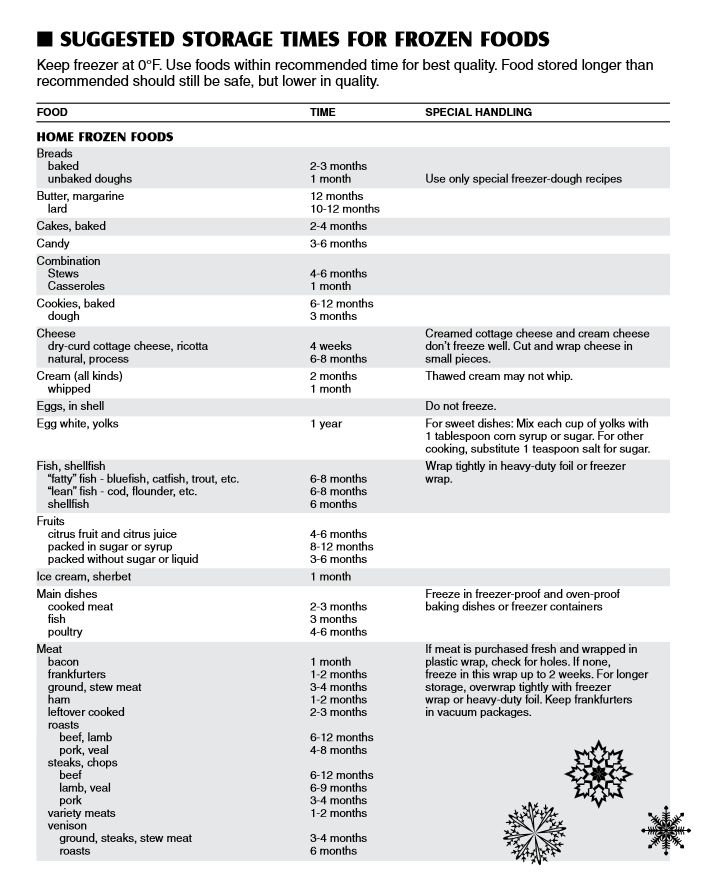
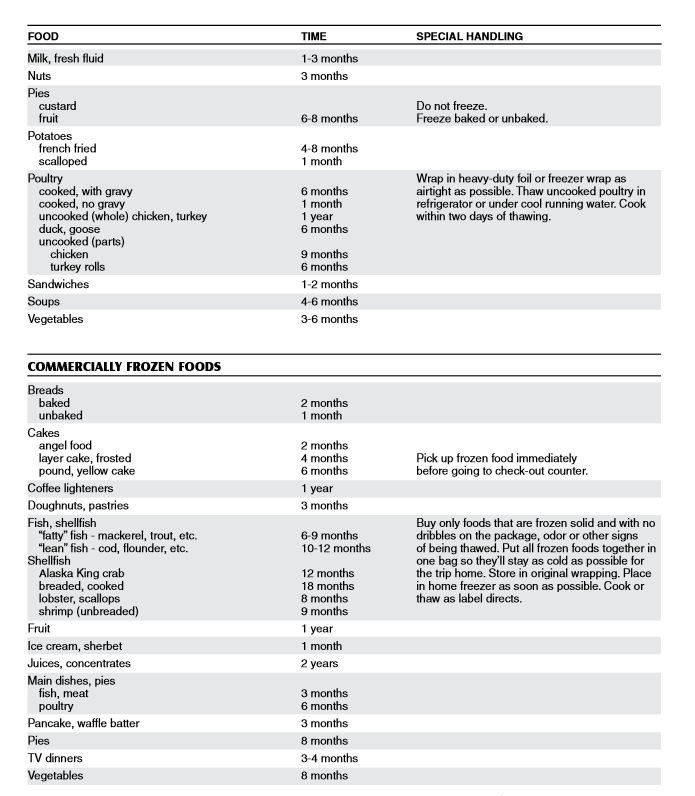
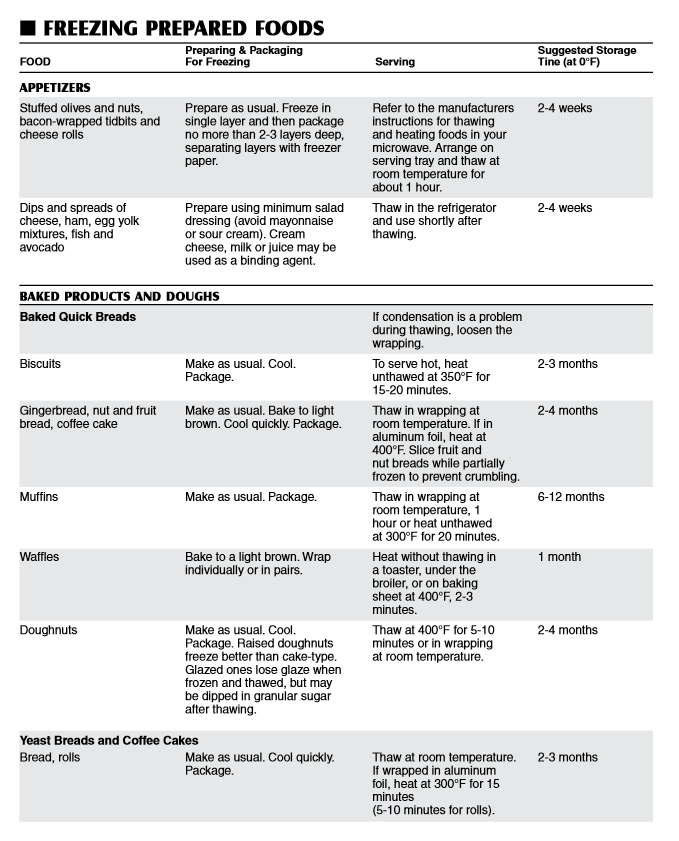
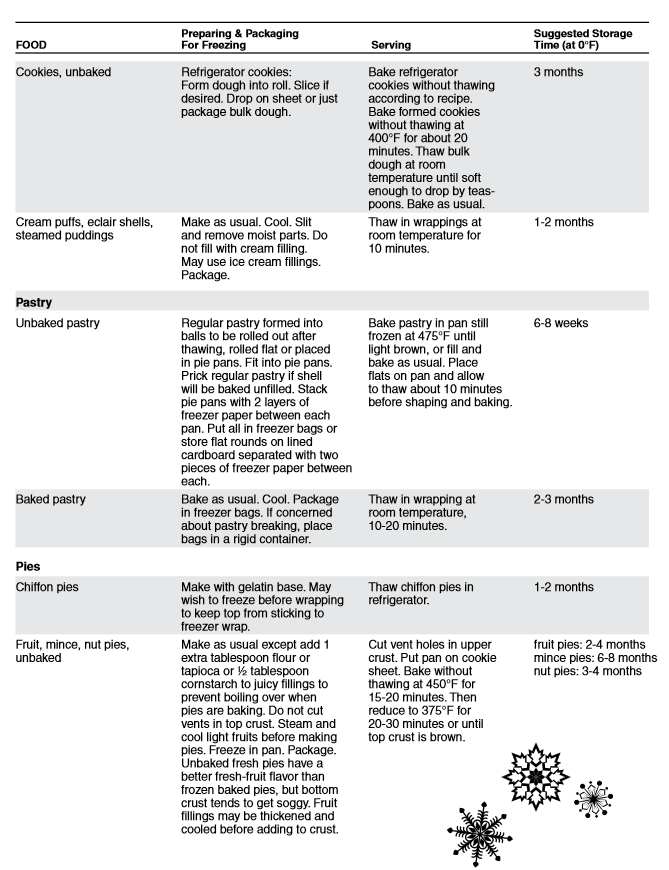
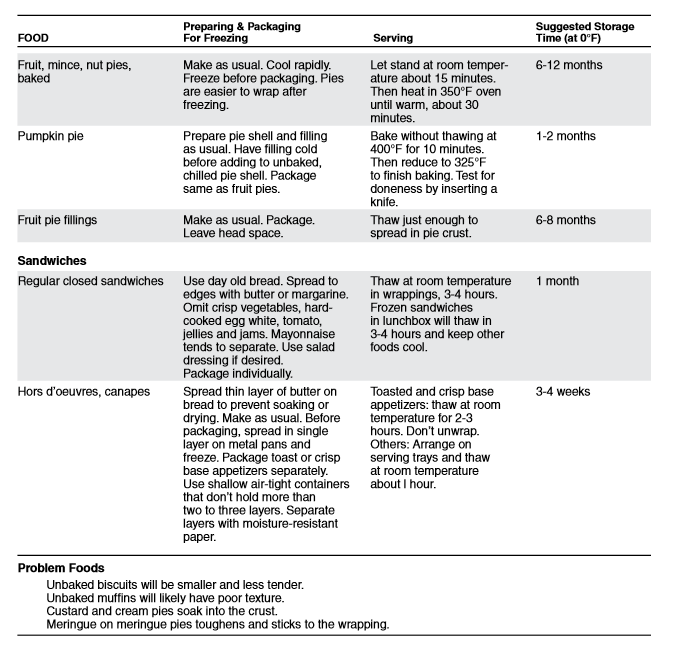
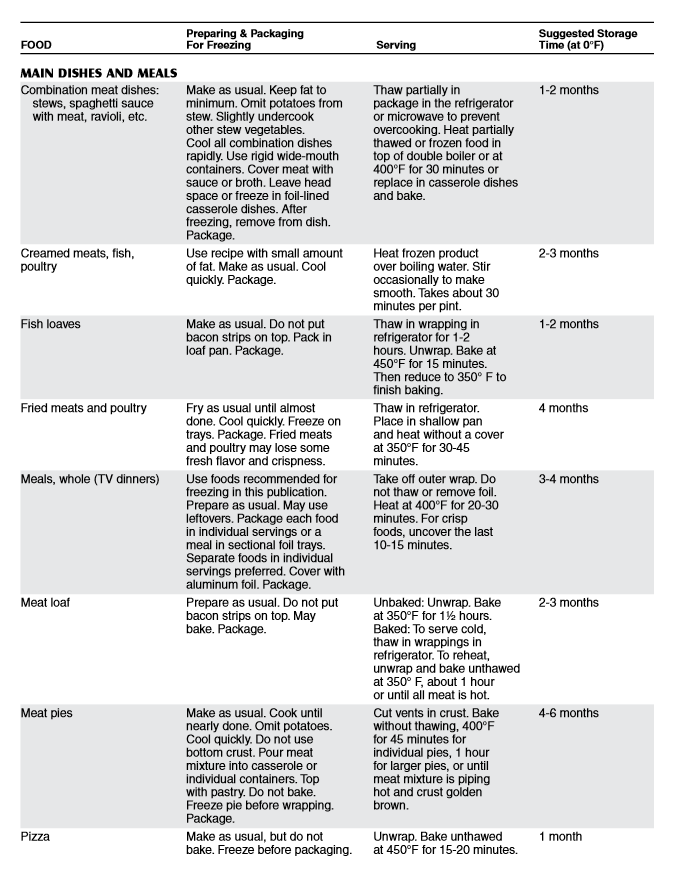
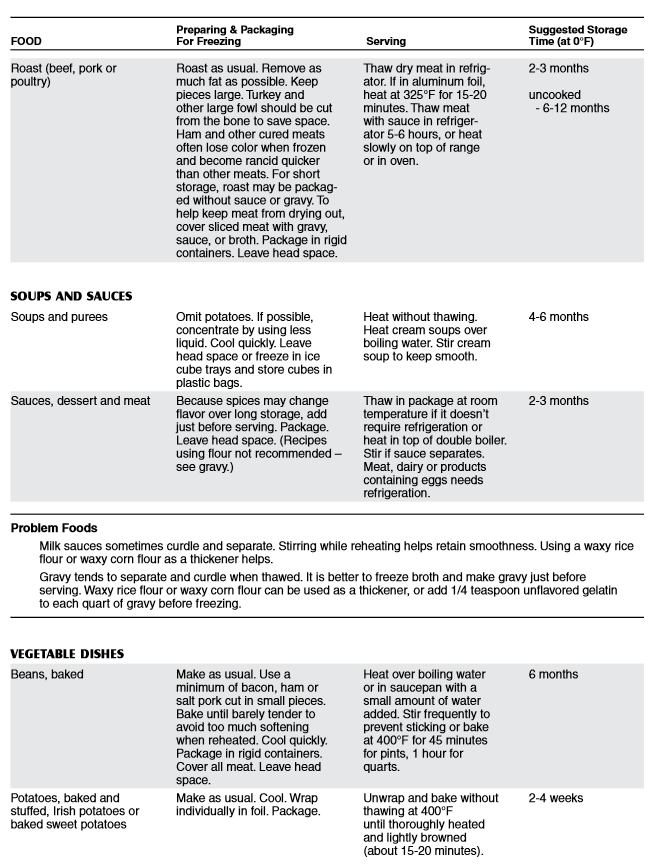
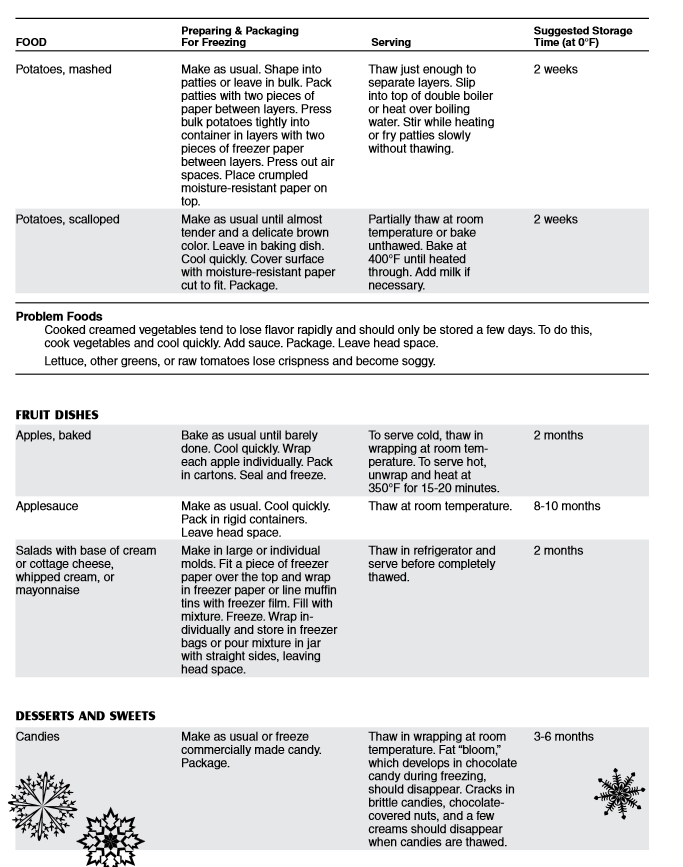

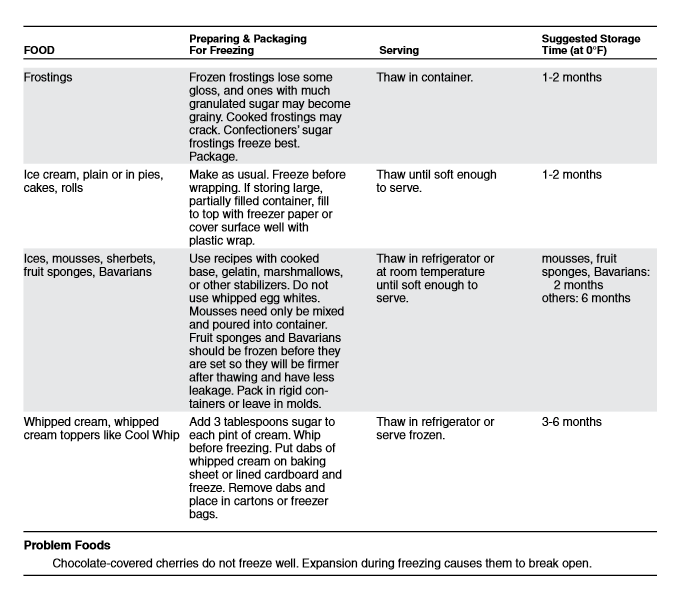
Reviewed February 2019

